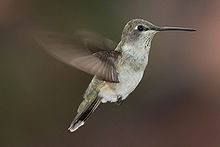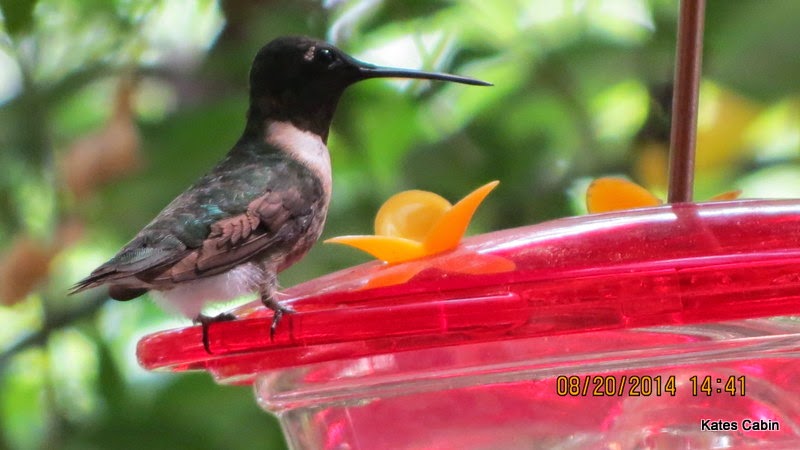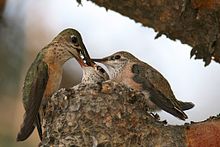
Hi Everybody!!
During the end of August, the male hummingbirds are still arriving and claiming their favorite branch. Your photostudy is from August 20, 2014. Temperatures still close to 100 make the birds thirsty. They are here to gain weight before the trip to Mexico. The early birds have been here for a couple of weeks and established a daily routine. All are waiting for the girls! I have shared facts from Wikipedia below about hummingbirds and history. Enjoy!

Link to Aug 20 photostudy:
https://plus.google.com/u/0/photos/117645114459863049265/albums/6059674267759151489




This date in History over 100 years:
http://en.wikipedia.org/wiki/August_20
August 20
From Wikipedia, the free encyclopedia
Events
- 1914 – World War I: German forces occupy Brussels.
- 1920 – The first commercial radio station, 8MK (now WWJ), begins operations in Detroit, Michigan.
- 1926 – Japan's public broadcasting company, Nippon Hōsō Kyōkai (NHK) is established.
- 1938 – Lou Gehrig hits his 23rd career grand slam, a record that stood for 75 years until it was broken by Alex Rodriguez.
- 1940 – In Mexico City, Mexico exiled Russian revolutionary Leon Trotsky is fatally wounded with an ice axe by Ramón Mercader. He dies the next day.
- 1940 – World War II: British Prime Minister Winston Churchill makes the fourth of his famous wartime speeches, containing the line "Never was so much owed by so many to so few".
- 1944 – World War II: 168 captured allied airmen, including Phil Lamason, accused by the Gestapo of being "terror fliers", arrive at Buchenwald concentration camp.
- 1944 – World War II: The Battle of Romania begins with a major Soviet Union offensive.
- 1950 – Korean War: United Nations repel an offensive by North Korean divisions attempting to cross the Naktong River and assault the city of Taegu.
- 1955 – In Morocco, a force of Berbers from the Atlas Mountains region of Algeria raid two rural settlements and kill 77 French nationals.
- 1960 – Senegal breaks from the Mali Federation, declaring its independence.
- 1962 – The NS Savannah, the world's first nuclear-powered civilian ship, embarks on its maiden voyage.
- 1968 – Soviet Union-dominated Warsaw Pact troops invade Czechoslovakia, crushing the Prague Spring.
- 1975 – Viking Program: NASA launches the Viking 1 planetary probe toward Mars.
- 1977 – Voyager Program: NASA launches the Voyager 2 spacecraft.
- 1986 – In Edmond, Oklahoma, U.S. Postal employee Patrick Sherrill guns down 14 of his co-workers and then commits suicide.
- 1988 – "Black Saturday" of the Yellowstone fire in Yellowstone National Park
- 1988 – Peru becomes a member of the Berne Convention copyright treaty.
- 1988 – Iran–Iraq War: A ceasefire is agreed after almost eight years of war.
- 1988 – The Troubles: Eight British soldiers are killed and 28 wounded when their bus is hit by an IRA roadside bomb in Ballygawley, County Tyrone.
- 1989 – The pleasure boat Marchioness sinks on the River Thames following a collision. Fifty-one people are killed.
- 1989 – The O-Bahn Busway in Adelaide, the world's longest guided busway, opens.
- 1991 – Dissolution of the Soviet Union, August Coup: More than 100,000 people rally outside the Soviet Union's parliament building protesting the coup aiming to depose President Mikhail Gorbachev.
- 1991 – Estonia, annexed by the Soviet Union in 1940, issues a decision on the re-establishment of independence on the basis of historical continuity of its pre-World War II statehood.
- 1993 – After rounds of secret negotiations in Norway, the Oslo Accords are signed, followed by a public ceremony in Washington, D.C. the following month.
- 1997 – Souhane massacre in Algeria; over 60 people are killed and 15 kidnapped.
- 1998 – The Supreme Court of Canada rules that Quebec cannot legally secede from Canada without the federal government's approval.
- 1998 – U.S. embassy bombings: The United States launches cruise missile attacks against alleged al-Qaeda camps in Afghanistan and a suspected chemical plant in Sudan in retaliation for the August 7 bombings of American embassies in Kenya and Tanzania.
- 2002 – A group of Iraqis opposed to the regime of Saddam Hussein take over the Iraqi Embassy in Berlin, Germany for five hours before releasing their hostages and surrendering.
- 2008 – Spanair Flight 5022, from Madrid, Spain to Gran Canaria, skids off the runway and crashes at Barajas Airport. One hundred forty-six people are killed in the crash, and eight more die later. Only 18 people survive.
- 2012 – A prison riot in the Venezuelan capital, Caracas, kills at least 20 people.
- 2014 – 72 people are killed in Japan's Hiroshima prefecture by a series of landslides caused by a month's worth of rain that fell in one day.

http://en.wikipedia.org/wiki/Hummingbird
Hummingbird
From Wikipedia, the free encyclopedia
| Hummingbird | |
|---|---|
 | |
| Female black-chinned hummingbird | |
| Scientific classification | |
| Kingdom: | Animalia |
| Phylum: | Chordata |
| Class: | Aves |
| Subclass: | Neornithes |
| Infraclass: | Neognathae |
| (unranked): | Cypselomorphae |
| Order: | Apodiformes |
| Family: | Trochilidae Vigors, 1825 |
Reproduction[edit]
| This section does not cite any references or sources. (May 2014) |
As far as is known, male hummingbirds do not take part in nesting.[33] Most species build a cup-shaped nest on the branch of a tree or shrub; although, a few tropical species normally attach their nests to leaves.[citation needed] The nest varies in size relative to the particular species—from smaller than half awalnut shell to several centimeters (1 centimeter = 0.39 inches) in diameter.[33]
Many hummingbird species use spider silk and lichen to bind the nest material together and secure the structure.[34] The unique properties of the silk allow the nest to expand as the young hummingbirds grow.[citation needed] Two white eggs are laid,[34] which, despite being the smallest of all bird eggs, are in fact large relative to the adult hummingbird's size. Incubation lasts 14 to 23 days,[34] depending on the species, ambient temperature and female attentiveness to the nest.[33] The mother feeds her nestlings on small arthropods and nectar by inserting her bill into the open mouth of a nestling, and then regurgitating the food into its crop.[33]
Wing structure and colors[edit]
Many of the hummingbird species have bright plumage with exotic coloration. In many species, the coloring does not come from pigmentation in the feather structure, but instead from prism-like cells within the top layers of the feathers. When light hits these cells, it is split into wavelengths that reflect to the observer in varying degrees of intensity. The hummingbird feather structure acts as a diffraction grating. The result is that, merely by shifting position, a muted-looking bird will suddenly become fiery red or vivid green. However, not all hummingbird colors are due to the prism feather structure. The rusty browns of Allen's and rufous hummingbirds come from pigmentation. Iridescent hummingbird colors actually result from a combination of refraction and pigmentation, since the diffraction structures themselves are made of melanin, a pigment.[35]
Torpor[edit]
Hummingbirds are capable of slowing their metabolism at night or any time food is not readily available, entering a hibernation-like, deep sleep state known as torpor needed to prevent energy reserves from falling to a critical level. During nighttime torpor, body temperature falls from 40oC to 18oC,[27] with heart and breathing rates both slowed dramatically (heart rate to roughly 50 to 180 beats per minute from its daytime rate of higher than 1000).[28]
During torpor, to prevent dehydration, the kidney glomerular filtration rate ceases, preserving needed compounds like glucose as a source of fuel, water and nutrients.[25] Further, body mass declines throughout nocturnal torpor at a rate of 0.04 g per hour, amounting to about 10% of weight loss each night.[25] The circulating hormone, corticosterone, is one signal that arouses a hummingbird from torpor.[29]
Use and duration of torpor vary among hummingbird species and are affected by whether a dominant bird defends territory, with non-territorial subordinate birds having longer periods of torpor.[30]
Lifespan[edit]
Hummingbirds have long lifespans for organisms with such rapid metabolisms. Though many die during their first year of life, especially in the vulnerable period between hatching and leaving the nest (fledging), those that survive may live a decade or more. Among the better-known North American species, the average lifespan is probably 3 to 5 years. By comparison, the smallershrews, among the smallest of all mammals, seldom live more than 2 years.[31] The longest recorded lifespan in the wild is that of a female broad-tailed hummingbird that was banded (ringed) as an adult at least one year old, then recaptured 11 years later, making her at least 12 years old. Other longevity records for banded hummingbirds include an estimated minimum age of 10 years 1 month for a female black-chinned similar in size to the broad-tailed, and at least 11 years 2 months for a much larger buff-bellied hummingbird.[32]

...this is brendasue signing off from Rainbow Creek. See you next time!

O+O





No comments:
Post a Comment